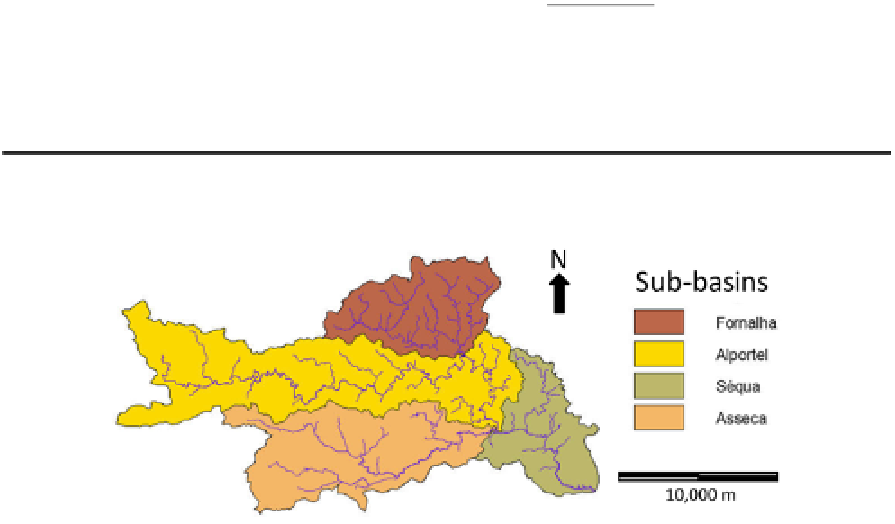Geography Reference
In-Depth Information
4.3.1. Hydrologic model
The Séqua/Gilão drainage basin has an area of 227 km
2
immediately upstream of Tavira.
This drainage basin can be divided into 4 sub-basins, namely: Alportel, Asseca, Fornalha
and Séqua (Figure 6). Characteristics of the sub-basins are shown in Table 9.
Characteristics of the drainage
sub-basins and rivers
Sub-basins
Alportel
Asseca
Fornalha
Séqua
Sub-basin area (km
2
)
93.12
61.35
40.06
32.31
Main river length (km)
49.07
19.77
15.06
14.25
Equivalent slope (m/km)
6.5
9.4
17.6
5.9
Time of Concentration (h)
9.2
4.0
2.5
3.7
Lag-time (h)
5.5
2.4
1.5
2.2
Table 9.
Major hydrological and physical characteristics of the drainage sub-basins and rivers of the
Séqua/Gilão River.
Figure 6.
Drainage basin of the Séqua/Gilão River immediately upstream of Tavira. The 4 sub-basins
are identified.
According to the Portuguese Soils Map (SROA, 1970) most of the soils of the Séqua/Gilão
drainage basin may be classified as “Ex - Lithosols of xeric regime climate, schists or
greywackes” (Cardoso, 1965). Soils properties were defined using field tests data (Koop
et
al.
, 1989). The soils hydrologic groups were defined (
e.g.
, Lencastre and Franco, 1992) as B, C
and D (US Soil Conservation Service Curve Number method). Group D was by far the most
common in the drainage basin. Soil use was acquired via the Corine Land Cover chart and
largely consists of forests and farmlands. According to the Curve Number method,
information on the soil types and uses were combined to obtain the CN II values, to which
soil types and uses determine the relationship between rainfall and effective rainfall for soil
moisture conditions between the wilting point and field capacity. However, in flood-related
studies, the soil moisture conditions should correspond to soils with high water content
which are able to reach or surpass field capacity, a situation that leads to the origin of larger
floods. Adjusted values (CN III) used in this study are shown in Figure 7.
The design hyetographs were obtained by using Intensity-Duration-Frequency curves
referred in the Portuguese Law (DR 23/95 of 23
rd
August) and the “alternating block





